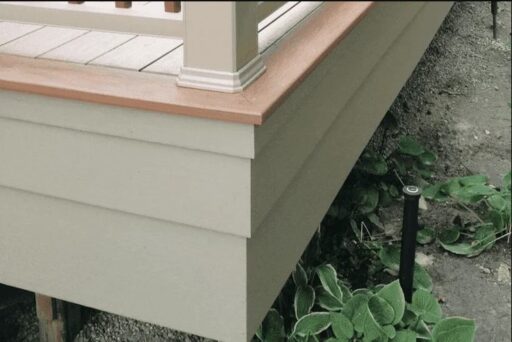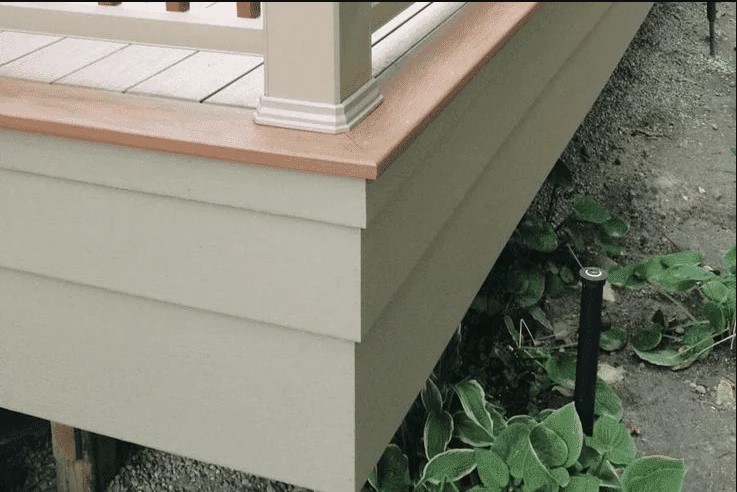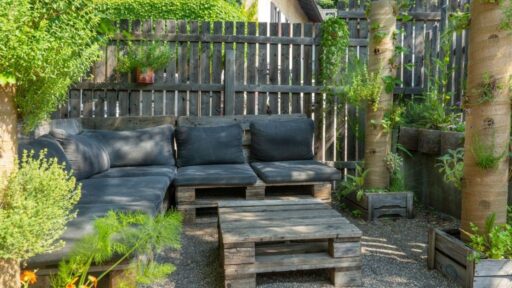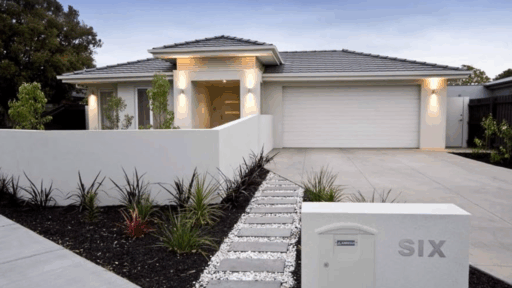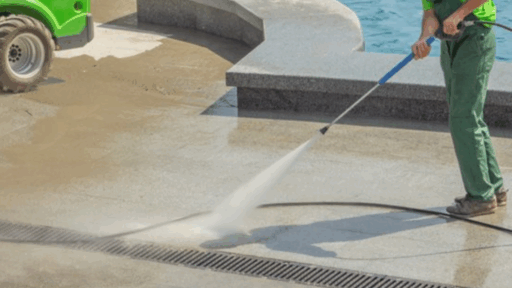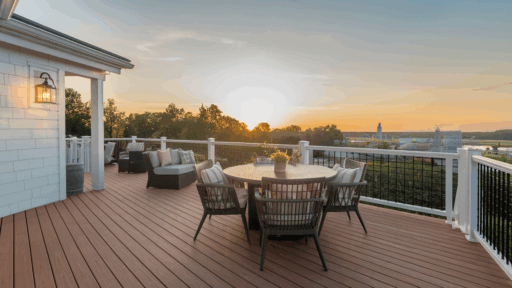When it comes to deck skirting, choosing the right materials can make all the difference. I’ve learned that not only does skirting enhance the aesthetic appeal of your deck, but it also protects the space underneath from pests and weather damage. With so many options available, it can be overwhelming to decide what’s best for your home.
In this article, I’ll share my insights on the most durable materials for deck skirting. Whether you’re looking for something low-maintenance or eco-friendly, I’ve got you covered. Let’s dive into the world of deck skirting and discover how to create a beautiful and lasting foundation for your outdoor space.
Composite Deck Skirting
Composite deck skirting combines durability and visual appeal, making it a popular choice for homeowners. Its unique formulation offers resistance against weather extremes and pests, enhancing the overall integrity of any deck.
Overview
Composite deck skirting consists of a blend of wood fibers and recycled plastic. This combination provides robust material that withstands the rigors of outdoor conditions. Many brands offer a variety of colors and textures, enabling easy integration into existing outdoor designs. A great example is Oakio decking, which is known for its exceptional quality and durability, making it a top choice for both decking and skirting.
Benefits
Composite deck skirting offers several advantages. First, its low maintenance requirements eliminate the need for regular staining or sealing. Second, the durability of composite materials means they resist fading, warping, and cracking. Lastly, it’s eco-friendly, utilizing recycled content while providing an attractive solution for protecting the underside of a deck.
Vinyl and PVC Skirting
Vinyl and PVC skirting serves as a popular choice for deck skirting due to their durability and low maintenance requirements. These materials resist weather damage, pests, and fading, making them suitable for various outdoor settings.
Overview
Vinyl skirting consists of a synthetic resin that offers a versatile range of colors and designs. PVC skirting, similar in composition, provides exceptional strength while remaining lightweight. Both options are non-porous, ensuring protection against moisture and rot.
Benefits
Durable and low maintenance, vinyl and PVC skirting don’t require regular painting or staining. They offer easy installation, often with interlocking panels, enhancing aesthetic appeal. Affordable compared to wood and composite options, these materials can withstand harsh weather, making them ideal for long-lasting deck skirting solutions.
Metal Skirting
Metal skirting offers a robust and stylish choice for deck skirting, enhancing both protection and aesthetic appeal. This option stands out due to its durability and low maintenance, making it a popular selection for homeowners.
Overview
Metal skirting primarily consists of materials like aluminum or steel, both of which provide excellent resistance to weather elements and pests. Aluminum skirting is lightweight yet strong, while steel offers unparalleled toughness. Metal skirting comes in various finishes and styles, allowing for customization to suit different deck designs.
Benefits
Metal skirting delivers numerous benefits, including superior durability against harsh conditions and insects. It’s resistant to rot and decay, ensuring a long-lasting solution for deck skirting. Installation remains straightforward, often utilizing interlocking panels that simplify the process. Additionally, metal skirting requires minimal upkeep, with occasional cleaning being sufficient to maintain its appearance.
Stone and Brick Skirting
Stone and brick skirting offers a sturdy and timeless option for deck skirting, providing aesthetic appeal alongside durability. This material stands up well against the elements, ensuring long-lasting protection for decks.
Overview
Stone skirting includes options like slate, granite, and limestone, while brick skirting typically consists of fired clay. These materials offer unique textures and colors, enhancing the overall look of the deck. Both stone and brick require careful installation, often involving mortar or other binding agents for stability and a polished finish.
Benefits
Stone and brick skirting deliver exceptional durability against weather conditions and pests. The materials resist rot, decay, and fading, making them ideal for lasting protection. Their heavyweight ensures stability, preventing shifts or damage over time. Maintenance involves occasional cleaning to preserve appearance, simplifying upkeep while enhancing the deck’s charm.
Wood and Wood Lattice Skirting
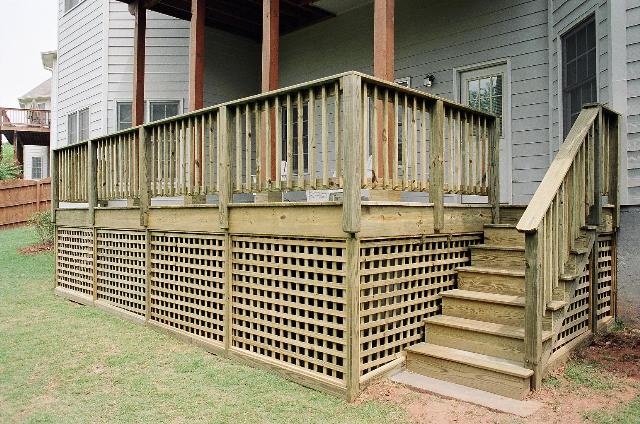
Wood and wood lattice skirting stands out as a classic choice for enhancing deck aesthetics and providing functional protection. This option combines natural beauty with structural advantages, making it a popular selection for many homeowners.
Overview
Wood skirting offers a traditional look that complements various deck styles. It’s available in various species like cedar, redwood, and pressure-treated lumber, each boasting unique characteristics. Wood lattice skirting adds elegance and ventilation, allowing air circulation while providing a decorative element that enhances the overall deck design.
Benefits
Wood skirting delivers several advantages. It has natural resistance to pests, particularly with pressure-treated options, ensuring a longer lifespan. Wood’s strength provides durability against harsh weather conditions. Additionally, wood allows for easy customization, making it simple to match specific aesthetics. Routine maintenance, such as staining or sealing, extends its longevity, ensuring the skirting remains attractive and functional.
Faux Stone and Brick Veneer
Faux stone and brick veneer represent a stylish and durable choice for deck skirting. This material captures the aesthetic of traditional stone and brick while offering lightweight installation and maintenance benefits.
Overview
Faux stone and brick veneer include synthetic options that mimic the look of natural materials. Generally made from polymer or composite materials, these veneers come in various colors and textures. Their design versatility makes them suitable for enhancing the beauty of any deck, blending seamlessly with various architectural styles.
Benefits
Faux stone and brick veneer offers numerous advantages for deck skirting. The lightweight nature simplifies installation, reducing labor costs. This material excels in weather resistance, preventing issues like rot or fading, and it requires minimal upkeep—only occasional cleaning is necessary. Additionally, faux veneers remain an affordable alternative to genuine stone or brick without sacrificing aesthetic appeal, making them a popular choice for long-lasting deck skirting solutions.
Alternative and DIY Options
I can explore several alternative and DIY options for durable deck skirting that blend aesthetic appeal with functionality. These choices provide budget-friendly solutions that enhance any outdoor space.
Mesh Screens
Mesh screens offer a practical solution for deck skirting, allowing airflow while preventing pest entry. These screens are easy to install and can be customized to match various deck designs. Made from durable materials, such as fiberglass or aluminum, mesh screens resist corrosion and decay, ensuring longevity.
Plank Fencing
Plank fencing creates a rustic look for deck skirting while ensuring robust protection against pests and weather. This option involves vertical or horizontal wooden planks, providing a classic aesthetic. Plank fencing is easy to install and can be painted or stained to match the deck, enhancing overall appeal.
Landscaping
Incorporating landscaping into deck skirting blends natural beauty with effective coverage. Using shrubs, flowers, or decorative rocks can create a visually pleasing barrier. Plants also offer benefits like improved drainage and pest control. This approach adds color and texture, making the deck area inviting.
Reed Screens
Reed screens serve as an attractive and lightweight option for deck skirting. These natural materials provide privacy while allowing air circulation. Easy to install, reed screens complement various deck styles and require minimal maintenance, making them a practical choice for enhancing outdoor living spaces.
Technical Considerations
When selecting materials for durable deck skirting, several technical aspects warrant attention. These considerations help ensure optimal functionality and longevity.
Ventilation
Ventilation plays a crucial role in deck skirting. Adequate airflow prevents moisture buildup, reducing the risk of rot and mold. Incorporating design features like vents or gaps allows for airflow while maintaining aesthetic appeal. This approach balances functionality with appearance, ensuring the deck remains in good condition.
Access
Access to the underside of the deck is essential for maintenance and inspections. Choosing materials that allow for easy removal or provide openings can simplify such tasks. If skirting obstructs access, it complicates cleaning and repairs, potentially leading to future issues that require more extensive work.
Building Codes
Adhering to building codes is vital when installing deck skirting. Local regulations may specify height, material, and ventilation requirements. Ensuring compliance guarantees safety and enhances the longevity of both the skirting and the overall deck structure. Consult local building authority guidelines to avoid costly fines or rework.
Cost
Cost considerations influence the choice of deck skirting materials. Options vary significantly in price based on durability, maintenance requirements, and aesthetics. While materials like composite may have a higher initial cost, their longevity can lead to savings over time. It’s beneficial to weigh upfront costs against long-term durability and upkeep.
Installation
Installation practices for deck skirting impact its effectiveness and appearance. Proper alignment and secure fastening ensure the skirting withstands weather elements. If using interlocking panels or individual boards, following the manufacturer’s guidelines for installation is essential. A well-installed system minimizes gaps and enhances the overall look of the deck.
Conclusion
Choosing the right materials for deck skirting is essential for both functionality and style. I love how the variety of options available allows for personal expression while ensuring durability. Whether you opt for the low-maintenance benefits of composite or the timeless charm of stone, each material brings something unique to the table.
Don’t forget to consider your specific needs and preferences when making your choice. With the right skirting in place, you can enhance your deck’s appearance while protecting it from the elements. Happy decking!

